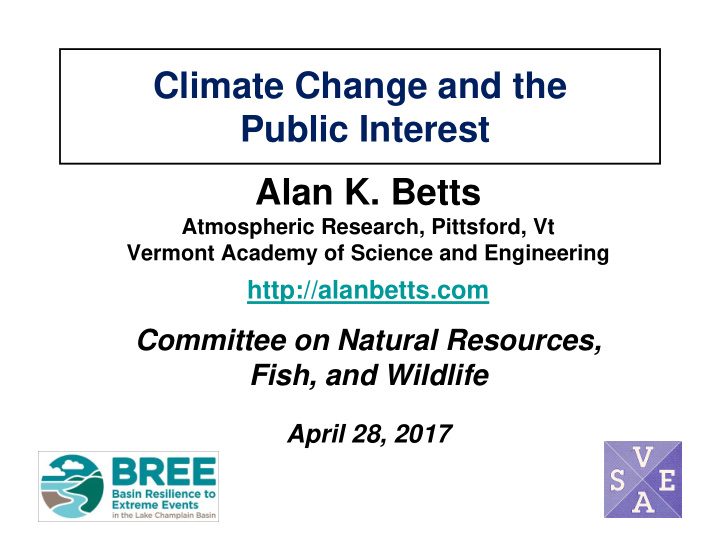



Climate Change and the Public Interest Alan K. Betts Atmospheric Research, Pittsford, Vt Vermont Academy of Science and Engineering http://alanbetts.com Committee on Natural Resources, Fish, and Wildlife April 28, 2017
Dr. Alan Betts (bio) • Independent Vermont climate scientist – funded by NSF and NASA since 1980 • Fellow of the AGU, AMS, RMS, AAAS • Past-president of Vermont Academy of Science and Engineering • Author of 170 reviewed papers • Recipient of several prestigious awards • Details at http://alanbetts.com/about
Climate Science is Critical • Climate change is accelerating – Shifting energy system away from fossil fuel is only way to slow down changes – Science and technology are critical • Social issues go far beyond science – Honesty is critical • Deception means Earth wins & we lose
An international coalition of 33 meteorological and climate societies and institutions have released a Collective Global Climate Statement to coincide with Earth Day on 22 nd April. “ The scientific evidence is now overwhelming: our planet is warming, largely due to emissions of greenhouse gases from human activities.”
Fundamentals • Burning fossil fuels: transforming climate – Many water cycle amplifying feedbacks – Heading for high CO 2 “Carboniferous era climate” – Ice melting; Climate extremes increasing • Avoidance of responsibility for decades – Politicians, professionals, public – Climate change accelerates with ‘business-as-usual’ • Linked to unmanaged waste streams – Soluble by changing system guidelines – Pricing CO 2 emissions – Create efficient society, based on renewable energy • Choices are value based
Sept 16, 2012 • Half the Arctic Sea Ice Melted in 2012 • Open water in Oct. Nov. gives warmer Fall in Northeast • Feedbacks amplify: • Less ice, less reflection of sunlight • More evaporation, larger vapor greenhouse effect • Same feedbacks as in our winters (Arctic sea-ice at new record lows: Oct 2016 - present) http://nsidc.org/arcticseaicenews/
Long-term Global Mean Trend 1880-2016
Gardening in Pittsford, Vermont in January January 7, 2007 January 10, 2008 December 2006: Warm Fall: • Warmest on record • Record Arctic sea-ice melt • Snow cover in December, ground unfrozen
February 5, 2016 (Digging in Feb. first time ever)
March 3, 2017
Vermont’s Reference Lake Frozen Period Shrinking: variability huge Steve Maleski: “Eye on the Sky”
Jan-Feb-Mar 2015 Warm Atlantic, cold NE, strong coastal storms - Boston record snow Jan-Feb-Mar 2016 Warm Atlantic, warm NE, little snow, warm Arctic
Vermont’s Future Climate with High and Low GHG Emissions What about VT forests? Sub-tropical Business drought areas as usual moving into southern US NECIA, 2007
Can We Stop “Dangerous Climate Change”? (UNFCCC 1992) • Yes: Quickly stabilize atmospheric CO 2 • This means an 80% drop in CO 2 emissions! • Technically possible but very difficult • Fossil fuels have driven our industrial growth and population growth for 200 years • “Lifestyle” has become dependent on fossil fuels • Powerful vested interests
Growth of CO 2 Emissions Flat for 3 years Rise of CO 2 China shifts to renewables - 3%/year China burns Need 80% coal drop by 2050
Efficiency Comes First • We need to double or triple our energy efficiency because… • We cannot replace current fossil fuel use with biofuels & renewable energy • Fossil fuel reserves are enough to push CO 2 to 1,000 ppm • Radically change climate/wipe-out many species • In time melt icecaps, raise sea-level 150ft
System Guidelines • Reeducation of society and its ‘systems’ – Transition is huge: needs change of mindset • Fully cost CO 2 emissions/pollution • Develop renewable energy – Power, housing, transport – Maximize energy efficiency
Issue of Values • Do we continue to exploit the Earth – For greater ‘economic growth’ – For a wealthy few – What will be left for our children? – What happens to the ecosystems we depend on? • Fundamental practical moral issue – Accept our responsibility for Earth’s future – Co-operate with the Earth (or we lose)
Discussion alanbetts.com (articles and talks)
What is a pollutant? • First it was the obvious hazards to health – Smoke/smog from burning coal and exhausts – Toxic contaminants dumped in drinking water – These were regulated by the Clean Air and Clean Water legislation in 1980’s & 1990’s • But many of our waste products that look harmless to humans are hazards to life on Earth – CFCs that destroy the ozone layer that protects life – CO 2 from burning fossil fuels, driving climate change – Plastics dumped into the oceans • In our disconnected human world, these are harder for us to deal with
Recommend
More recommend